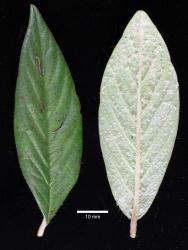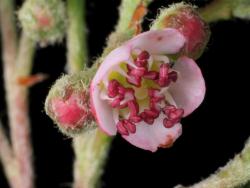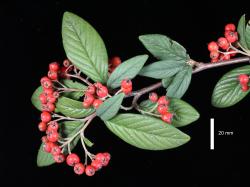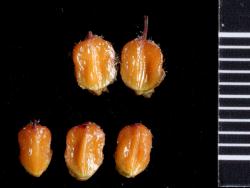- = Cotoneaster rugosus E.Pritz. (1900)
- = Cotoneaster salicifolius var. rugosus Rehder & E.H.Wilson in Sargent, Pl. Wilson. 1(2), 172–173 (1912) nom. nov.
Erect shrub, c. 1.5 m. Branchlets green-brown, lenticels sparse, branchlet hairs a dense, white tomentum; stipule 3.0 mm long, green, with moderately dense white hairs. Leaves evergreen, crowded on branches, 55 mm long, lamina 51 mm long, 21 mm wide, elliptical, plane, c. 310 µm thick, petiole 4 mm long, with dense white hairs; leaf base cuneate; leaf apex acute with apiculus bent downwards; lateral veins in 7 pairs, midvein and lateral veins impressed above and projecting below; upper surface moderately rugose, mid-green, semi-glossy, upper surface hairs very sparse, becoming glabrous; margins recurved, glabrous; lower surface not visible or glaucous, hairs on lower surface of young leaf dense, white, fine and tangled, woolly and floccose, becoming sparse with age.
Inflorescence a compound corymb of 48–52 flowers, 4 leaves per fascicle, 40–50 mm long, rachis hairs dense, white, woolly; pedicel 0–3.0 mm long, hairs dense, white, woolly. Flowers 7.0–9.0 mm diameter. Hypanthium green, red at margins and on sepals, sepals 0.8–1.3 mm long, 2.0 mm wide, hairs dense, white, woolly, rubbing off from the sepals. Petals dark pink in bud, when open semi-spreading, pink, almost white at the petal base when open, 2.9–3.2 mm long, 3.2–3.5 mm wide, base not clawed, tuft of hairs absent, margins slightly irregular. Stamens 20–23; filaments 3.2 mm long, white; anthers red-purple with almost-black dots in cells of anthers, 0.7–0.8 mm long; styles 2–3, 2.0 mm long. Fruit strong red (RHS 39A), almost spherical, 6.0–6.5 mm long, 6.5–7.5 mm diameter, calyx somewhat open with pyrenes slightly visible, fruit skin hairs sparse to none. Pyrenes 2–3 in equal numbers, 3.7–4.0 mm long, 2.5–3.3 mm wide, hairs sparse at apex, slightly umbonate, style attached at pyrene apex.
Leaves evergreen, leathery, rugose, c. 50 mm long × 20 mm wide, narrowly elliptical. Upper leaf surface dark green, initially sparsely hairy with 7 pairs of deeply impressed veins, leaf margins recurved, lower surface glaucous, initially densely pilose, with age the hairs rub off. Flowers 48–52 per corymb, petals dark pink in bud, when open semi-spreading, pink but almost white at the petal base, glabrous, filaments white, anthers red-purple with black dots. Pyrenes equally 2 or 3 per fruit, style at pyrene apex.
Most similar to Cotoneaster salicifolius. The two are probably indistinguishable without flowers. Both have narrowly elliptical leaves that are quite strongly rugose. The petals of C. hylmoei are pink and semi-spreading while they are white and fully spreading in C. salicifolius.
In cultivation at Dunedin Botanic Gardens (2014–2015). Not recorded in any New Zealand horticultural trade catalogue.
Flowering: December; Fruiting: April
Tetraploid (Fryer & Hylmö 2009)







